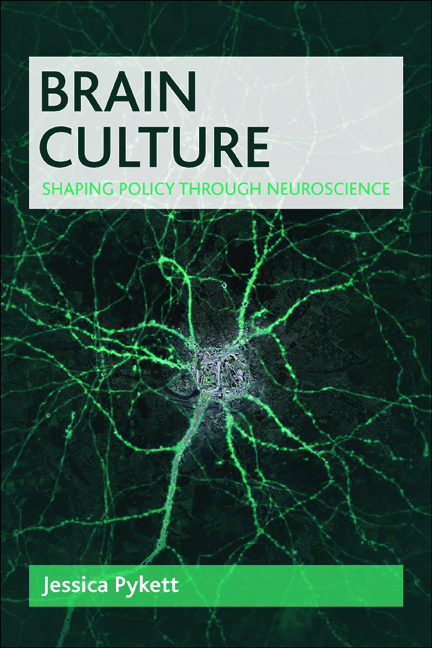Book contents
- Frontmatter
- Dedication
- Contents
- About the author
- Acknowledgements
- Preface
- One Introduction: governing through brain culture
- two Brain culture in context
- three Designing cerebral cities
- four Teaching the learning brain
- five Managing workplace emotions
- six Conclusion: what is at stake in the brain world?
- References
- Index
three - Designing cerebral cities
Published online by Cambridge University Press: 10 March 2022
- Frontmatter
- Dedication
- Contents
- About the author
- Acknowledgements
- Preface
- One Introduction: governing through brain culture
- two Brain culture in context
- three Designing cerebral cities
- four Teaching the learning brain
- five Managing workplace emotions
- six Conclusion: what is at stake in the brain world?
- References
- Index
Summary
I contend that architectural design can change our brains and behaviour. (Fred Gage, 2009, p xiv)
Introduction
Since the late 1990s, neuroarchitecture has emerged as a paradigm for integrating new neuroscientific knowledge with architectural education and practice. Neuroarchitecture seeks to establish applied approaches to planning, design and engineering which take into account both the effects of the built environment on brain activity, and the neurological correlates of space perception – the influence of the world around us on our embodied cognition and our behaviour. This chapter introduces some of the main ideas behind neuroarchitecture, and places it in the broader context of environmental psychology and urban design disciplines – tracing common paradigms and identifying key methodological distinctions where necessary. Attempts to design particular behaviours into spatial environments or buildings, and design practices that are explicitly aimed at shaping healthier places or better learning environments, are highlighted.
The chapter explores some of the practical and conceptual difficulties of pursuing interdisciplinary investigations into neuroscience and architecture, and considers the problems associated with translating neuroscientific research evidence into applications in real places. The notion of ‘spatial behaviour’ is investigated, and the way in which neuroscientists, architects and urban designers conceive of the ‘environment’ said to shape human behaviour is further examined, in light of the geographical analysis of contextual rationalities outlined in the previous chapter. This discussion raises a set of overtly democratic questions. First, concerning the extent to which neuroarchitecture can be considered scalable, how valid is the neuromolecular gaze in designing and governing spatial environments for individuals, specific social groups and whole populations at these different scales? Second, what is the appropriate role of ‘spatial experts’ in designing behaviourally informed built environments through which people are incited to govern themselves and also be governed through their brains? And finally, to what extent might the new techniques of neuroarchitecture carry with them an intensification of the processes by which to subjectivise citizens by enabling the governance of our attention? Put another way, how does the phenomena of neuroarchitecture – manifest in new interdisciplinary research practices and urban design policies – have the potential to re-shape our relationships to ourselves and to our brains in particular spaces?
Brains and buildings
Neuroarchitecture refers to the interdisciplinary endeavours of neuroscientists and architects currently working together in order to discover how our brains respond to architectural experiences. This approach, still in its infancy, has been developed largely through the activities of ANFA, established by the American Institute of Architects in San Diego, California in 2003 (Eberhard, 2009, p vii).
- Type
- Chapter
- Information
- Brain CultureShaping Policy through Neuroscience, pp. 71 - 96Publisher: Bristol University PressPrint publication year: 2015

